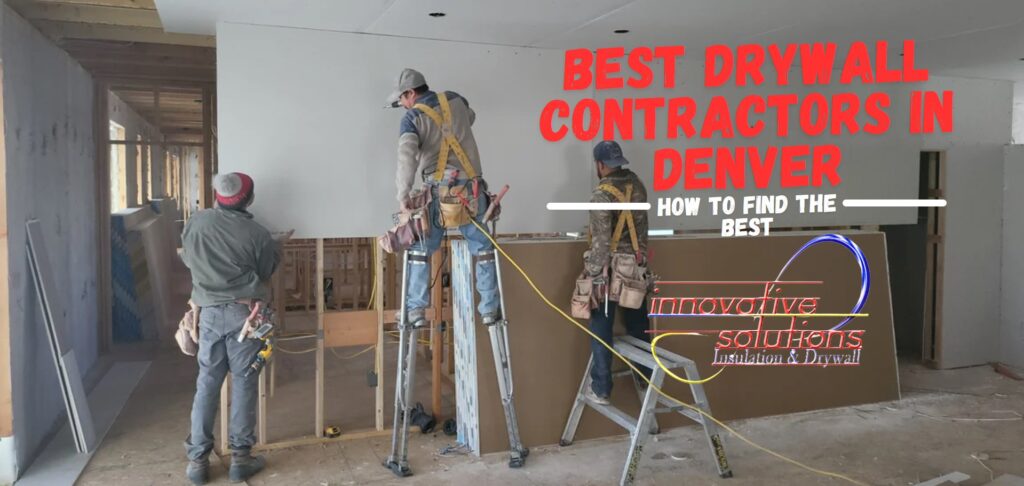Denver’s cold winters and hot summers immediately affect the drywalls, leading to cracks around seams and nail pops. Besides, proper insulation is essential for maintaining energy efficiency and reducing utility bills.
- Cellulose vs Fiberglass Insulation in Denver
- Origins of Cellulose and Fiberglass
- Key Differences: Cellulose vs Fiberglass Insulation in Denver
- Climate-Specific Considerations
- Installation and Maintenance
- Cost-Effectiveness Of Cellulose Vs Fiberglass Insulation
- Environmental Impact Of Cellulose Vs Fiberglass Insulation
- Which is Better: Cellulose or Fiberglass Insulation?
- What Are the Disadvantages of Cellulose Insulation?
- Is Fiberglass a Form of Cellulose?
- What is Better Than Fiberglass insulation?
- How Does Climate Impact Insulation Choice in Denver?
Well, using cellulose or fiberglass insulating material can prevent these inevitable issues. However, weighing the benefits and comparing cellulose vs fiberglass insulation in Denver before choosing one is important. Careful consideration can save money and provide long-term benefits.
I will be helping you understand the benefits and drawbacks of the two most used insulation materials.
Origins of Cellulose and Fiberglass
Fiberglass is the oldest insulation material introduced by Owens-Corning company in the 1930s to recycle leftover glass. However, its market demand increased as an insulating material due to its fire resistance and drywall protection properties.
Whereas cellulose is an eco-friendly drywall insulation material made from recycled plant-based materials like newsprints. Although introduced in the late 1950s, it became a popular alternative to fiberglass insulation in the United States in the 1970s.
Cellulose is a considerably newer technique to insulate drywalls.
Key Differences: Cellulose vs Fiberglass Insulation in Denver
Cellulose and fiberglass are the two common drywall insulation building materials with significant differences. Therefore, cellulose vs fiberglass insulation in Denver is not a new research topic for Colorado homeowners.
Let me walk you through the main features of each material.
| Feature | Cellulose | Fiberglass |
| Material | Recycled paper with fire retardant and borate treatments | Spun glass fibers |
| R-Value (per inch) | 3.7 - 4.2 | 2.2 - 2.5 |
| Cost | Moderate | Affordable |
| Installation | Requires specialized equipment for blowing in | Easier DIY installation with batts or rolls |
| Environmental Impact | Eco-friendly, made from recycled materials | Can cause skin and eye irritation during installation |
| Moisture Management | Absorbs and releases moisture, reducing condensation risk | Susceptible to mold growth if not properly installed |
| Sound Control | Excellent sound-dampening properties | Good sound absorption |
| Fire Resistance | High, with added fire retardant treatments | Non-combustible with added chemicals |
| Durability | Can settle over time, requiring frequent top-ups | Maintains thickness and R-value over time |
Climate-Specific Considerations
Denver’s cold winters and less humid summers badly impact drywall insulations. Therefore, it’s necessary to use insulation material with optimal R-value to maintain temperature and humidity.
Cellulose has a higher R-value per inch vs fiberglass insulation and provides better temperature maintenance. Although it absorbs and releases moisture, the water-splashed installation reduces the risk of condensation buildup within walls after rain.
Fiberglass is less durable and settles over a long time if not installed professionally. It needs thick layer placement to fulfill the needs of Colorado temperature and prevent heat loss in winter. Thus, always consult a professional for drywall insulation in Denver.
My expert team at ISID has in-depth knowledge about Denver climate and R-value requirements. They can help you choose the suitable material for better results.
Installation and Maintenance
Cellulose and fiberglass insulation each require unique preparation and maintenance. Where cellulose needs water spray for better installation, fiberglass needs protective gears for safety.
Let’s understand the installation and maintenance requirements of cellulose vs fiberglass insulation through the table.
| Aspect | Cellulose Insulation | Fiberglass Insulation |
| Installation | It needs professional installation and requires spraying with water to settle uniformly. | DIY-friendly but requires careful handling with protective gear against fiberglass particles. |
| Installation Preparation | Prepare the area by clearing debris and ensuring a dry environment. | Clear the area and wear protective clothing and goggles. |
| Installation Process | Typically blown-in; It requires professional installation for optimal performance. | Available in batts or blown-in; DIY-friendly but professional installation is recommended for best results. |
| Ease of Installation | Moderate difficulty; requires specialized equipment for blowing in the material. | Batts are easier to handle, and blown-in requires professional equipment but are less complex than cellulose. |
| Time Required | Installation can be completed relatively quickly, usually within a few hours for an average-sized home. | Batts are quicker to install, but blown-in fiberglass takes a similar time to cellulose. |
| Health and Safety Concerns | Requires protective gear due to dust and potential for respiratory irritation. | Requires protective gear to avoid skin and respiratory irritation from glass fibers. |
| Maintenance Requirements | Settling over time may require periodic checks and top-offs. | Typically stable over time; occasional checks for moisture or damage are recommended. |
Cost-Effectiveness Of Cellulose Vs Fiberglass Insulation
Blown-in fiberglass and cellulose insulation installation are similar in product purchase. However, you will need professional help to install cellulose vs fiberglass insulation in Denver. It will subsequently add to the cost.
Despite additional installation costs, cellulose offers more benefits making it a cost-effective option compared to fiberglass in the long run.
- Requires less maintenance.
- Minimizes the workload of the HVAC system by preventing air leakage.
- Long-term effectiveness compared to fiberglass that settles over time.
- IRA offers incentives to use eco-friendly materials for building and insulation.
At ISID, we don’t offer a one-size-fits-all approach to insulation. We understand that different areas of your home benefit from specific insulation types. For instance, you can use fiberglass for open attics and cellulose for insulating rooms.
My team creates a customized insulation plan that maximizes comfort, energy efficiency, and cost savings.
Environmental Impact Of Cellulose Vs Fiberglass Insulation
Several online research analyses proved significant differences in energy efficiency and environmental impact of cellulose vs fiberglass insulation.
Cellulose reduces landfill waste significantly as it is made from 85% recycled paper.
In contrast, fiberglass manufacturing requires a lot of energy, which emits excessive greenhouse gases. However, incorporating 20-30% recycled glass in fiberglass products has reduced some environmental impacts. It’s less durable and still increases landfills.
Besides, the higher R-value of cellulose vs fiberglass insulation provides better insulation while minimizing the load on the HVAC system. It results in lower energy consumption and reduced reliance on fossil fuels.
People Also Ask
Which is Better: Cellulose or Fiberglass Insulation?
Cellulose is more eco-friendly and has a higher R-value, while fiberglass is more affordable and easier for DIY installation.
What Are the Disadvantages of Cellulose Insulation?
Cellulose can settle over time, requiring periodic top-ups, and it needs professional installation with specialized equipment.
Is Fiberglass a Form of Cellulose?
No, fiberglass is made from spun glass fibers, whereas cellulose is made from recycled paper treated with fire retardants.
What is Better Than Fiberglass insulation?
Cellulose is often considered better due to its higher R-value, eco-friendliness, and better moisture management.
How Does Climate Impact Insulation Choice in Denver?
Denver’s climate necessitates insulation with a high R-value for better temperature and humidity control, making cellulose a favorable option.
In my expert opinion, cellulose insulation is better than fiberglass as it’s more eco-friendly and energy-efficient. However, fiberglass can also provide sufficient insulation if installed professionally. So, the effectiveness of cellulose vs fiberglass insulation in Denverdepends on how well it’s installed.
You can also go for a mixed approach and use both insulation materials according to their effectiveness in Denver.
Contact us at ISID for home audits and carefully created plans under budget.




